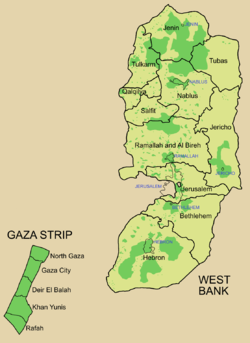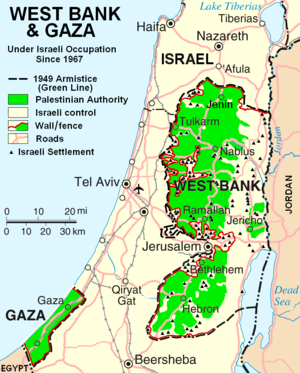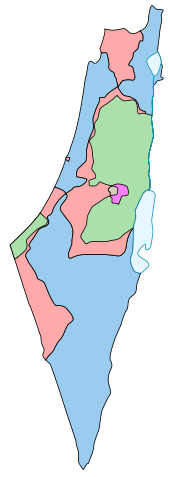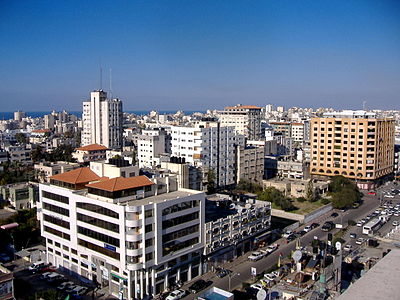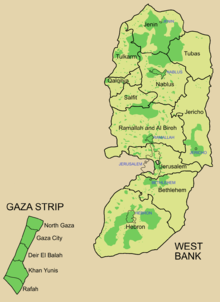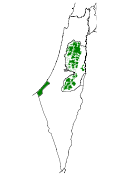- Palestinian territories
-
Not to be confused with Palestinian National Authority, State of Palestine, or Palestine (region).
Palestinian Territories 
Flag Anthem: Fida'i Map showing areas of Palestinian Authority control or joint control (Areas A and B) in deep greenCapital Administrative centers: Ramallah (West Bank), Gaza (Gaza Strip); East Jerusalem is the proclaimed capital of Palestine[1]
Official language(s) Arabic, Hebrew, and English Government Semi-presidential;
Parliamentary democracy- President Mahmoud Abbasa - Prime Minister Ismail Haniyehb Establishment - Established May 4, 1994 Population - 2009 (July) estimate 3,935,249[2] (126th) GDP (PPP) 2009 estimate - Total $$12.95 billion (-) - Per capita $2,900 (-) HDI (2010) 0.645[3] (medium) (97th) Currency [citation needed] Jordanian dinarc
Egyptian Poundd
Israeli new sheqele (JOD, EGP, ILS)Time zone (UTC+2) - Summer (DST) (UTC+3) Internet TLD .ps, فلسطين. Calling code +970f Notes a b c d e f- a Abbas's term expired on 9 January 2009, creating a constitutional crisis. Abbas unilaterally extended his term by one year, while Duwaik, as the Speaker of the Palestinian Legislative Council, assumed the office as well.
b Haniyeh was dismissed by President Abbas in favor of Fayad, however, along with the Palestinian Legislative Council, Haniyeh does not acknowledge the legitimacy of his dismissal; from 14 June 2007 Haniyeh exercises de facto authority in the Gaza Strip, whereas Fayad's government has authority in the West Bank.
c Used in West Bank from 1950–present
d Used in Gaza Strip from 1951–present
e Used from 1985–present
f +972 is also used
The Palestinian territories comprise the West Bank and the Gaza Strip. Since the Palestinian Declaration of Independence in 1988, the region is today recognized by three-quarters of the world's countries as the State of Palestine or simply Palestine,[4] although this status is not recognized by the United Nations, Israel and major Western nations such as the United States. The UN and international legal bodies often refer to the region as the Occupied Palestinian Territories.
From the 1948 Arab–Israeli War until the 1967 Six Day War, the West Bank was occupied by Jordan and the Gaza Strip by Egypt. Both are currently occupied by Israel according to the international community, although Israel has denied that it occupies the Gaza Strip.[5][6][7] The Palestinian National Authority regards East Jerusalem as part of the West Bank, and consequently a part of the Palestinian territories, while Israel regards it as part of Israel as a result of its annexation in 1980. 'Palestinian territories' is one of a number of designations for these areas. The territories were part of the territory west of the Jordan River of Mandate Palestine, formed in 1922. In March 1946, the territory east of the Jordan River, which had been ruled as a separate province of Mandate Palestine, became the independent kingdom of Transjordan, though general international recognition took a bit longer. The Palestinian territories were captured and occupied by Transjordan (the West Bank) and by Egypt (the Gaza strip) in 1948, and acquired their current boundaries at the cessation of fighting in the 1948 Arab–Israeli War, which were delineated in the 1949 Armistice Agreements.[8] Israel captured and occupied the territories in the 1967 Six-Day War. In 1980 Israel annexed East Jerusalem, but United Nations Security Council Resolution 478 declared it "null and void" and required that it be rescinded, stating that it was a violation of international law. The annexation lacks international recognition.[6] The 1949 Armistice Agreements that ended that war did not create permanent borders, but only temporary boundaries until a permanent peace agreement could be reached. Nevertheless, Jordan captured East Jerusalem along with the entire West Bank during the 1948 Arab-Israeli War and tried to annex it in 1950, though it was widely considered unlawful.[9] After losing it in 1967, Jordan renounced all territorial claims to East Jerusalem and the West Bank in 1988.
Israel's legal rationale for the annexation of East Jerusalem principally revolves around the belief that conquest resulting from a defensive use of force entitles the victor to unilaterally annex occupied territory. According to the Israeli Supreme Court, the Fourth Geneva Convention, which prohibits unilateral annexation of occupied territory, does not apply to East Jerusalem, as there was no "legitimate sovereign" there prior.[citation needed] The Palestinian National Authority, which maintains a territorial claim to East Jerusalem, never exercised sovereignty over the area.[citation needed] However, this reasoning has not been recognized by any other country, since unilateral annexation of territory conquered during war contravenes the Fourth Geneva Convention.[10][11] Many believe that the city should be internationalized to guarantee freedom of religion and the security of holy sites.[citation needed] Following the signing of the Oslo Accords in 1993, portions of the territories have been governed to varying degrees by the Palestinian Authority.
Contents
Name
See also: Timeline of the name PalestineThere are disagreements over what the Palestinian territories should be called.
The United Nations, the International Court of Justice, the European Union, International Committee of the Red Cross and the government of the United Kingdom all refer to the "Occupied Palestinian Territories".[12][13][14] Journalists also use the description to indicate lands outside the Green Line.[citation needed] The term is often used interchangeably with the term occupied territories, although this term is also applied to the Golan Heights, which is internationally recognized as part of Syria and not claimed by the Palestinians. The confusion stems from the fact that all these territories were captured by Israel during the 1967 Six-Day War and are treated by the UN as territory occupied by Israel.
Other terms used to describe these areas collectively include 'the disputed territories', 'Israeli-occupied territories', and 'the occupied territories'. Further terms include "Yesha" (Judea-Samaria-Gaza), Yosh (Judea and Samaria), the Katif Strip (Gaza Strip), "administered territories", "territories of undetermined permanent status", "1967 territories", and simply "the territories".
Many Arab and Islamic leaders,[who?] including some Palestinians,[who?] use the designation 'Palestine' and 'occupied Palestine' to imply a Palestinian political or religious claim to sovereignty over the whole former territory of the British Mandate west of the Jordan River, including all of Israel.[15] Many[who?] of them view the land of Palestine as an Islamic Waqf (trust) for future Muslim generations. A parallel exists in the aspirations of David Ben-Gurion,[16] Menachem Begin,[17][18] and other Zionists and Jewish religious leaders[who?] to establish Jewish sovereignty over all of Greater Israel in trust for the Jewish people.[19][20] However, this dispute is not related to religion for many Arabs, but simply an issue of rights, as he land was inhabited by Arabs (as well as a minority of Jews) before the Zionist movement began.
Many Israelis[who?] object to the term "Occupied Palestinian Territories", and similar descriptions, because they maintain such designations disregard legitimate Israeli claims to the West Bank and Gaza, or prejudice negotiations involving possible border changes, arguing that the armistice line agreed to after the 1948 Arab-Israeli War was not intended as a permanent border. Dore Gold wrote, "It would be far more accurate to describe the West Bank and Gaza Strip as "disputed territories" to which both Israelis and Palestinians have claims."[21]
Boundaries
See also: Borders of IsraelThe Palestinian Territories consist of two (or perhaps three) distinct areas: the Gaza Strip, the West Bank and East Jerusalem. Israel regards East Jerusalem not to be a part of the West Bank, but regards it is as part of a unified Jerusalem, which it unilaterally considers the Capital of the state. The eastern limit of the West Bank is the border with Jordan. The Israel–Jordan peace treaty defined that border as the international border, and Jordan renounced all claims to territory west of it. The border segment between Jordan and the West Bank was left undefined pending a definitive agreement on the status of the territory.[22]
The southern limit of the Gaza Strip is the border with Egypt. Egypt renounced all claims to land north of the international border, including the Gaza Strip, in the Israel-Egypt peace treaty. The Palestinians were not parties to either agreement.
The natural geographic boundary of the West Bank, as the name implies, is the Jordan River. The Gaza Strip is bounded by the Mediterranean Sea.
It is now generally accepted, at least as a basis for negotiation between the sides, that the boundaries between the West Bank and the Gaza Strip and the State of Israel are what has historically been referred to as the Green Line.[citation needed] The Green Line represents the armistice lines under the 1949 Armistice Agreements, which brought an end to the 1948 Arab-Israeli War and expressly declared armistice lines, not international borders.
Between the Armistice of 1949 and the Six-Day War of 1967, the West Bank and East Jerusalem were occupied and annexed by Jordan and the Gaza Strip was occupied (but not annexed) by Egypt. The term "Palestinian" began to be applied exclusively to the Arab population of these areas only after Israel's victory in the 1967 War, and consequently the terms "Palestinian Territories" and "Occupied Palestinian Territories" also gained wide usage. Until the start of serious negotiations for a settlement of the Israeli-Palestinian issues (the Peace Process), the Palestinians refrained from defining the boundaries of what they called "the occupied territories," and which some even called "occupied Palestine", which implied a potential Palestinian claim to the whole of Israel. It was in the context of the negotiations that the term "1967 borders" came to be used, as a basis for negotiation. "The 1967 borders" are in fact the 1949 armistice lines (which is the Green Line), which all Arab countries and Palestinians at the time insisted were to be temporary and with no other legal status. The Palestinian negotiators claim a return to those lines as the boundary for a future Palestinian state. The Palestinians also claim that East Jerusalem is a part of the occupied West Bank within the boundaries of the "1967 borders". The Arab League has supported these boundaries as the borders of the future State of Palestine in the 2002 Arab Peace Initiative.
History
Main article: History of Palestine (region)In 1922 after the collapse of the Ottoman Empire that ruled Greater Syria for four centuries (1517–1917), the British Mandate for Palestine was established. Large-scale Jewish immigration from abroad, mainly from Eastern Europe took place during the British Mandate, though Jewish immigration started during the Ottoman period.[23][24] The future of Palestine was hotly disputed between Arabs and Jews. In 1947, the total Jewish ownership of land in Palestine was 1,850,000 dunams or 1,850 square kilometers, which is 7.04% of the total land of Palestine.[25] Public property or "crown lands", the bulk of which was in the Negev, belonging to the government of Palestine may have made up as much as 70% of the total land; with the Arabs, Christians and others owning the rest.[26]
The 1947 United Nations Partition Plan proposed a division of Mandate Palestine between an Arab and a Jewish state, with Jerusalem and the surrounding area to be a corpus separatum under a special international regime. The regions allotted to the proposed Arab state included what became the Gaza Strip, and almost all of what became the West Bank, as well as other areas.
The Partition Plan was passed by the UN General Assembly on November 1947. The Partition Plan was accepted by the Jewish leadership, but rejected by the Arab leaders. The Arab League threatened to take military measures to prevent the partition of Palestine and to ensure the national rights of the Palestinian Arab population. One day before the expiration of the British Mandate for Palestine, on 14 May 1948, Israel declared its independence within the borders of the Jewish State set out in the Partition Plan. US President Harry Truman recognized the State of Israel de facto the following day. The Arab countries declared war on the newly formed State of Israel heralding the start of the 1948 Arab-Israeli War.
After the war, which Palestinians call the Nakba, the 1949 Armistice Agreements established the separation lines between the combatants, leaving Israel in control of some of the areas designated for the Arab state under the Partition Plan, Transjordan in control of the West Bank and East Jerusalem, Egypt in control of the Gaza Strip and Syria in control of the Himmah Area.
In 1950 Jordan annexed the West Bank and East Jerusalem. Only the United Kingdom formally recognized the annexation of the West Bank, de facto in the case of East Jerusalem.[27] In the Gaza Strip the Arab League formed the All-Palestine Government, which operated under Egypt occupation.
Article 24 of the Palestinian National Charter of 1964, which established the Palestine Liberation Organization,[28] stated: "This Organization does not exercise any territorial sovereignty over the West Bank in the Hashemite Kingdom of Jordan, on the Gaza Strip or in the Himmah Area" (i.e. the areas of the former Mandate Palestine controlled by Jordan, Egypt and Syria, respectively).
Israel captured both territories in the 1967 Six-Day War, besides other territory belonging to Egypt and Syria. Since then these territories have been designated Israeli-occupied territories. Immediately after the war, on June 19, 1967, the Israeli government offered to return the Golan Heights to Syria, the Sinai to Egypt and most of the West Bank to Jordan in exchange for peace. At the Khartoum Summit in September, the Arab parties responded to this overture by declaring "no peace with Israel, no recognition of Israel and no negotiations with Israel."[29]
UN Security Council Resolution 242 introduced the "Land for Peace" formula for normalizing relations between Israel and its neighbors. This formula was used when Israel returned the Sinai Peninsula to Egypt in 1979 in exchange for a peace treaty. While that treaty mentioned a "linkage" between Israeli-Egyptian peace and Palestinian autonomy, the formerly Egyptian-occupied territory in Gaza was excluded from the agreement, and remained under Israeli control.
The Oslo Accords of the early 1990s between the Palestine Liberation Organization and Israel led to the creation of the Palestinian Authority. This was an interim organization created to administer a limited form of Palestinian self-governance in the territories for a period of five years during which final-status negotiations would take place. The Palestinian Authority carried civil responsibility in some rural areas, as well as security responsibility in the major cities of the West Bank and the Gaza Strip. Although the five-year interim period expired in 1999, the final status agreement has yet to be concluded despite attempts such as the 2000 Camp David Summit, the Taba summit, and the unofficial Geneva Accords.
In 2005, Israeli forces withdrew from the Gaza Strip, ceding full effective internal control of the territory to the Palestinian Authority.
Since the Battle of Gaza (2007) the two separate territories, the Gaza Strip and the West Bank, are divided into a Hamas leadership in the Gaza Strip and a Fatah civil leadership in the autonomous areas of the West Bank. Each sees itself as the administrator of all Palestinian Territories and does not acknowledge the other one as the official government of the territories. The Palestinian Territories have therefore de facto split into two entities.
Political status
The political status of the territories has been the subject of negotiations between Israel and the Palestine Liberation Organization (PLO) and of numerous statements and resolutions by the United Nations. (See List of United Nations resolutions concerning Israel.) Since 1994, the autonomous Palestinian National Authority has exercised various degrees of control in large parts of the territories, as a result of the Declaration of Principles contained in the Oslo Accords. The United States government considers the West Bank and Gaza as a single entity for political, economic, legal and other purposes.[30] The State Department and other US government agencies, such as USAID West Bank and Gaza,[31] have been tasked with projects in the areas of democracy, governance, resources, and infrastructure. Part of the USAID mission is to provide flexible and discrete support for implementation of the Quartet Road Map.[32] The Road Map is an internationally backed plan that calls for the progressive development of a viable Palestinian State in the West Bank and Gaza. Participating states provide assistance through direct contributions or through the Palestinian State account established by the World Bank.[33]
After Hamas won a majority of seats in elections for the Palestinian Parliament, the United States and Israel instituted an economic blockade of the Gaza Strip.[34][35] When that failed to topple the new government, a covert operation was launched to eliminate Hamas by force.[36][37][38] The covert initiative was exposed when confidential State Department documents were accidentally leaked by the US envoy. The talking points delivered to the Fatah leadership said:
Hamas should be given a clear choice, with a clear deadline: they either accept a new government that meets the Quartet principles, or they reject it. The consequences of Hamas’ decision should also be clear: If Hamas does not agree within the prescribed time, you should make clear your intention to declare a state of emergency and form an emergency government explicitly committed to that platform.[39]Since the Battle of Gaza (2007), the administration of the territories has been contested by two rival factions of the Palestinian National Authority, with Hamas controlling the Gaza Strip and Fatah continuing to administer the West Bank. Both groups claim legitimacy over leadership of the Palestinian territories. Most countries with an interest in the issues, including most of the Arab countries, recognize the administration of Mahmoud Abbas as the legitimate government over both Palestinian Territories.[who?]
During Operation Cast Lead the UN Security Council adopted Resolution 1860 (2009), which said that the Gaza Strip constitutes an integral part of the territory occupied in 1967 that will be a part of the Palestinian state.[40]
Legal status
See also: International law and the Arab-Israeli conflict, Political status of the West Bank and Gaza Strip, and Status of territories captured by IsraelThe international community regards the West Bank and East Jerusalem as territories occupied by Israel, and, although it has withdrawn its military forces, Israel continues to be designated the occupying power in the Gaza Strip by the United Nations, the United States, the United Kingdom and various human rights organizations.[41][42] The final status of the Palestinian Territories as an independent state is supported by the countries that form the Quartet's "Road map for peace". The government of Israel has also accepted the road map but with 14 reservations.[43]
Customary international law, including the Fourth Geneva Convention, has been widely interpreted as prohibiting Israel from building settlements, due to its clauses prohibiting the transfer of a civilian population into an occupied territory.[44] This was reaffirmed December 5, 2001, at the Conference of High Contracting Parties to the Fourth Geneva Convention. The participating High Contracting Parties called upon Israel "to fully and effectively respect the Fourth Geneva Convention in the Occupied Palestinian Territory, including East Jerusalem, and to refrain from perpetrating any violation of the Convention. They reaffirm the illegality of the settlements in the said territories and of the extension thereof."[41] Article 47 of the Fourth Geneva Convention prohibits any change of status in occupied territory concluded through negotiations between the occupying power and local authorities under occupation. Critics point out that implementation of the Oslo Accords has not improved conditions for the population under occupation.[45] Israel contends that the settlements are not illegal as the West Bank is considered a "disputed territory" under international law. United Nations Security Council Resolution 242 recognized Israel's rights to "safe and secure borders", which has been interpreted as meaning that Israel had a right to West Bank territory for secure borders. The San Remo Conference, binding under international law, further envisioned the West Bank as being part of a sovereign Jewish state, and arguably encourages, rather than prohibits Jewish settlement in the area. Furthermore, many of the settlements were established on the sites of former Jewish communities that had existed there prior to 1947 on land that was legitimately bought, and ethnically cleansed by Arab forces. Israel views the territory as being the subject of legitimate diplomatic dispute and negotiation under international law.[46][47] East Jerusalem, captured in 1967, was unilaterally annexed by Israel. The UN Security Council Resolution 478 condemned the annexation as "a violation of international law". This annexation has not been recognized by other nations, although the United States Congress declared its intention to recognize the annexation (a proposal that has been condemned by other states and organizations). Because of the question of Jerusalem's status, no states base their diplomatic missions there and treat Tel Aviv as the capital,[48] though two states have embassies in the Jerusalem suburb of Mevaseret Zion. Israel asserts that these territories are not currently claimed by any other state, and that Israel has the right to control them.
Israel's position has not been accepted by most countries and international bodies, and the West Bank, East Jerusalem, and the Gaza Strip are referred to as occupied territories (with Israel as the occupying power) by most international legal and political bodies,[49] the rest of the Arab bloc, the UK,[50] including the EU, the United States,([6], [7][dead link]), both the General Assembly and Security Council of the United Nations,[51] the International Court of Justice, the Conference of High Contracting Parties to the Fourth Geneva Convention,[52] and the Israeli Supreme Court (see Israeli West Bank barrier).
Some countries and international figures seem to have accorded some credibility to Israel's position. Former U.S. President George W. Bush stated, during his presidency, that he did not expect Israel to return entirely to pre-1967 borders, due to "new realities on the ground."[53] However, the longstanding policy of the United States called upon Israel to offer territorial compensation.[54]
Both U.S. President Bill Clinton and U.K. Prime Minister Tony Blair, who played notable roles in attempts at mediation, noted the need for some territorial and diplomatic compromise on this issue, based on the validity of some of the claims of both sides.[55][56] One compromise offered by Clinton would have allowed Israel to keep some settlements in the West Bank, especially those in large blocks near the pre-1967 borders of Israel. In return, Palestinians would have received concessions of land in other parts of the country.[57] The United Nations did not declare any change in the status of the territories as of the creation of the Palestinian National Authority between 1993 and 2000, although a 1999 U.N. document[49] implied that the chance for a change in that status was slim at that period.
During the period between the 1993 Oslo Accords and the Second Intifada beginning in 2000, Israeli officials claimed that the term "occupation" did not accurately reflect the state of affairs in the territories. During this time, the Palestinian population in large parts of the territories had a large degree of autonomy and only limited exposure to the IDF except when seeking to move between different areas. Following the events of the Second Intifada, and in particular, Operation Defensive Shield, most territories, including Palestinian cities (Area A), are back under effective Israeli military control, so the discussion along those lines is largely moot.
In the summer of 2005, Israel implemented its unilateral disengagement plan; about 8500 Israeli citizens living in the Gaza Strip were forcibly removed from the territory; some received alternative homes and a sum of money. The Israel Defense Forces vacated Gaza in 2005, but invaded it again in 2006 in response to rocket attacks and the abduction of Israeli soldier Gilad Shalit by Hamas.
In January 2010, King Abdullah of Jordan, after a meeting with the Israeli president Shimon Peres at the World Economic Forum in Davos, declared that his country does not want to rule the West Bank and that "the two-state solution" to the Israeli-Palestinian conflict was the only viable option. If rule over the territory was to be transferred to the kingdom, it would only "replace Israeli military rule with Jordanian military rule... and the Palestinians want their own state."[58]
In December 2010, Brazil recognized Palestine as a state with its 1967 borders. This move was later followed by Argentina, Peru, Uruguay, Bolivia and Ecuador. This action was later criticized by Israel and the United States, who labelled it "counterproductive".[59]
Governorates structure
Main article: Governorates of the Palestinian National AuthorityThe Constitution of the League of Arab States says the existence and independence of Palestine cannot be questioned de jure even though the outward signs of this independence have remained veiled as a result of force majeure.[60] The League supervised the Egyptian trusteeship of the Palestinian government in Gaza after the termination of the British Mandate and secured assurances from Jordan that the 1950 Act of Union was "without prejudice to the final settlement".[61][62]
By the 1988 declaration, the PNC empowered its central council to form a government-in-exile when appropriate, and called upon its executive committee to perform the duties of the government-in-exile until its establishment.[63]
Under the terms of the Oslo Accords signed between Israel and the PLO, the latter assumed control over the Jericho area of the West Bank and the Gaza Strip on 17 May 1994. On September 28, 1995, following the signing of the Israeli-Palestinian Interim Agreement on the West Bank and Gaza Strip, Israeli military forces withdrew from the West Bank towns of Nablus, Ramallah, Jericho, Jenin, Tulkarem, Qalqilya and Bethlehem. In December 1995, the PLO also assumed responsibility for civil administration in 17 areas in Hebron.[64] While the PLO assumed these responsibilities as a result of Oslo, a new temporary interim administrative body was set up as a result of the Accords to carry out these functions on the ground: the Palestinian National Authority (PNA).
An analysis outlining the relationship between the PLO, the PNA (or PA), Palestine and Israel in light of the interim arrangements set out in the Oslo Accords begins by stating that, "Palestine may best be described as a transitional association between the PA and the PLO." It goes on to explain that this transitional association accords the PA responsibility for local government and the PLO responsibility for representation of the Palestinian people in the international arena, while prohibiting it from concluding international agreements that affect the status of the occupied territories. This situation is said to be accepted by the Palestinian population insofar as it is viewed as a temporary arrangement.[65]
In March 2008 it was reported that the PA was working to increase the number of countries that recognize Palestine and that a PA representative had signed a bilateral agreement between the State of Palestine and Costa Rica.[66] A recent Al-Haq position paper said the reality is that the PA has entered into various agreements with international organizations and states. These instances of foreign relations undertaken by the PA signify that the Interim Agreement is part of a larger on-going peace process, and that the restrictions on the foreign policy operations of the PA conflict with the inalienable right of the Palestinian people to self-determination, now a norm with a nature of jus cogens, which includes a right to engage in international relations with other peoples.[67]
Population
Main article: Palestinian peopleCommunication
Main article: Communications in the Palestinian territoriesTransportation
Main article: Transport in the Palestinian territoriesSee also
- Outline of the Palestinian territories
- Definitions of Palestine
- Economy of the Palestinian territories
- Human rights in the Palestinian National Authority
- Racism in the Palestinian territories
- Occupation of the Gaza Strip by Egypt
- Occupation of the West Bank and East Jerusalem by Jordan
- One-state solution
- Palestinian Environmental NGOs Network
- Palestinian flag
- Proposals for a Palestinian state
- Water, Sanitation and Hygiene Monitoring Program
- Coordinator of Government Activities in the Territories
References
- ^ The Palestine Basic Law, approved by the PLC in May 2002, states in the article 3 "Jerusalem is the Capital of Palestine" (source: Palestinianbasiclaw.org). Ramallah is the administrative capital and the location of government institutions as well as the foreign representative offices of Australia, Brazil, Canada, Colombia, Czech Republic, Denmark, Finland, Germany, Malta, the Netherlands, South Africa, and Switzerland. Jerusalem's final status awaits future negotiations between Israel and the Palestinian Authority (see "Negotiating Jerusalem", University of Maryland[dead link]). The United Nations and most countries do not accept Israel's claim over the whole of Jerusalem (see Kellerman 1993, p. 140) and maintain their embassies to Israel in other cities (see the CIA Factbook).
- ^ [1][dead link]
- ^ http://hdr.undp.org/en/media/Lets-Talk-HD-HDI_2010.pdf
- ^ Note that the term Palestine has historically referred to the region which today incorporates Israel as well as the Palestinian territories. The current position was expressed by Mahmoud Abbas in his September 2011 speech to the United Nations: "When we adopted this program, we were taking a painful and very difficult step for all of us, especially those, including myself, who were forced to leave their homes and their towns and villages, carrying only some of our belongings and our grief and our memories and the keys of our homes to the camps of exile and the Diaspora in the 1948 Al-Nakba, one of the worst operations of uprooting, destruction and removal of a vibrant and cohesive society that had been contributing in a pioneering and leading way in the cultural, educational and economic renaissance of the Arab Middle East. Yet, because we believe in peace and because of our conviction in international legitimacy, and because we had the courage to make difficult decisions for our people, and in the absence of absolute justice, we decided to adopt the path of relative justice - justice that is possible and could correct part of the grave historical injustice committed against our people. Thus, we agreed to establish the State of Palestine on only 22% of the territory of historical Palestine - on all the Palestinian Territory occupied by Israel in 1967. [2]
- ^ Le More, Anne (2008). International assistance to the Palestinians after Oslo: political guilt, wasted money. Routledge studies on the Arab-Israeli conflict. 1. London and New York: Routledge. p. 27. ISBN 9780415453851.
- ^ a b "West Bank/Gaza (Occupied Palestinian Territories) Information". America-Mideast Educational and Training Services Inc. (AMIDEAST). http://www.amideast.org/westbank/country_info.htm. Retrieved 2009-01-03.[dead link]
- ^ "December Overview" (PDF). UNOCHA. December 2009. http://www.ochaopt.org/documents/ocha_opt_the_humanitarian_monitor_2010_01_18_english.pdf. Retrieved 2010-01-03.
- ^ Egypt Israel Armistice Agreement UN Doc S/1264/Corr.1 23 February 1949
- ^ Jordan's annexation was recognized only by the United Kingdom and Pakistan.
- ^ The Right of Conquest By Sharon Korman
- ^ Dugard, John (1987). Recognition and the United Nations. Cambridge: Grotius Publications Limited. pp. 111–115. ISBN 052146322X.
- ^ UK Government Foreign Office[dead link]
- ^ "House of Commons International Development Committee - FINAL REPORT Vol I 26 January 2004" (PDF). http://www.publications.parliament.uk/pa/cm200304/cmselect/cmintdev/230/230.pdf. Retrieved 2010-06-30.
- ^ International Committee of the Red Cross[dead link]
- ^ see for example:The Covenant of the Islamic Resistance Movement 18 August 1988
- ^ The British labour movement and Zionism, 1917-1948. Routledge. 1983. p. 138. ISBN 9780714631622. "The Jewish people have always regarded, and will continue to regard Palestine as a whole, as a single country which is theirs in a national sense and will become theirs once again. No Jew will accept partition as a just and rightful solution."
- ^ Chomsky, Noam (1999). Fateful triangle: the United States, Israel, and the Palestinians. South End Press. p. 161. ISBN 9780896086012.
- ^ Shlaim, Avi (2008). The Iron Wall: Israel and the Arab World. Paw Prints. p. 670. ISBN 9781435295131.
- ^ see for example: Open a Bible
- ^ The Likud—Platform states "The Government of Israel flatly rejects the establishment of a Palestinian Arab state west of the Jordan River. The Palestinians can run their lives freely in the framework of self-rule, but not as an independent and sovereign state."
- ^ [From 'Occupied Territories' to 'Disputed Territories,' Dore Gold, Jerusalem Center for Public Affairs. http://www.jcpa.org/JCPA/Templates/ShowPage.asp?DBID=1&LNGID=1&TMID=111&FID=380&PID=1864&IID=1115]
- ^ http://untreaty.un.org/unts/144078_158780/11/6/4045.pdf
- ^ History[dead link], Civil Society Network on the Question of Palestine, Division for Palestinian Rights, United Nations.
- ^ Mark A. Tessler, A History of the Israeli-Palestinian conflict. page 211
- ^ British_mandate#Land_ownership_of_the_British_Mandate_of_Palestine
- ^ Alexander Safian, Can Arabs Buy Land in Israel?, Middle East Quarterly Volume IV, Number 4, December 1997; citing Moshe Aumann, Land Ownership in Palestine 1880–1948, Israel Academic Committee on the Middle East (undated, approximately 1970). The Negev statement is in Aumann.
- ^ Announcement in the UK House of Commons of the recognition of the State of Israel and also of the annexation of the West Bank by the State of Jordan. Commons Debates (Hansard) 5th series, Vol 474, pp1137-1141. April 27, 1950. scan (PDF)
- ^ Palestinian National Charter[dead link], 1964
- ^ "Khartoum Resolutions". Mideastweb.org. 1967-06-19. http://www.mideastweb.org/khartoum.htm. Retrieved 2010-06-30.
- ^ "Department of the Treasury, Customs Service, T.D. 97–16, Country of Origin Marking of Products From the West Bank and Gaza" (PDF). http://www.gpo.gov/fdsys/pkg/FR-1997-03-14/pdf/97-6434.pdf. Retrieved 2010-06-30.
- ^ "USAID West Bank/Gaza". Usaid.gov. http://www.usaid.gov/wbg/home.html. Retrieved 2010-06-30.
- ^ "West Bank and Gaza - Strategic Objective: 294-001" (PDF). http://www.usaid.gov/policy/budget/cbj2005/ane/pdf/294-001.pdf. Retrieved 2010-06-30.
- ^ Embassy of France. "International Donors’ Conferences for the Palestinian State". Ambafrance-us.org. http://ambafrance-us.org/spip.php?article1037. Retrieved 2010-06-30.
- ^ British Jewish group sparks outrage with Gaza blockade criticism[dead link]
- ^ "Gaza’s Future, Henry Siegman, London Review of Books". Lrb.co.uk. http://www.lrb.co.uk/v30/n03/sieg01_.html. Retrieved 2010-06-30.
- ^ Bay of Pigs in Gaza, Tom Segev, Haaretz[dead link]
- ^ Suzanne Goldenberg in Washington (2008-03-04). "US plotted to overthrow Hamas after election victory, Suzanne Goldenberg, The". London: Guardian. http://www.guardian.co.uk/world/2008/mar/04/usa.israelandthepalestinians. Retrieved 2010-06-30.
- ^ "Rabin Made Mistake Arming Arafat - Olmert Makes Same Mistake Arming Abbas". Zoa.org. http://www.zoa.org/sitedocuments/pressrelease_view.asp?pressreleaseID=104. Retrieved 2010-06-30.
- ^ "The Gaza Bombshell, David Rose, Vanity Fair, April 2008, page 3". Vanityfair.com. 2009-10-20. http://www.vanityfair.com/politics/features/2008/04/gaza200804?currentPage=3. Retrieved 2010-06-30.
- ^ "See the text of UN Security Council Resolution 1860 (2009)". Un.org. 2009-01-08. http://www.un.org/News/Press/docs/2009/sc9567.doc.htm. Retrieved 2010-06-30.
- ^ a b Conference of High Contracting Parties to the Fourth Geneva Convention: Declaration, Dec 5, 2001, UN website.
- ^ Israel/Occupied Palestinian Territories: The conflict in Gaza: A briefing on applicable law, investigations and accountability Amnesty International. 2009-01-19. Retrieved 2009-06-05; Human Rights Council Special Session on the Occupied Palestinian Territories Human Rights Watch, July 6, 2006; Is Gaza 'occupied' territory? CNN, January 6, 2009. Retrieved 2009-05-30.
- ^ Israeli Cabinet Statement on Road Map and 14 Reservations, May 25, 2003
- ^ The Mitchell Report BBC, November 29, 2001
- ^ Occupation, Colonialism, Apartheid?, Human Sciences Research Council, May 2009, page 71
- ^ Israeli Settlements and International Law, Israel Foreign Ministry website, 5/4/01, accessed 12/18/07.
- ^ "Occupied Territories" to "Disputed Territories" by Dore Gold, Jerusalem Center for Public Affairs, January 16, 2002. Retrieved September 29, 2005.
- ^ "Foreign Missions in Israel -Continents". Mfa.gov.il. 2007-05-30. http://www.mfa.gov.il/MFA/Sherut/ForeignInIsrael/Continents/. Retrieved 2010-06-30.
- ^ a b United Nations International Meeting on the Convening of the Conference on Measures to Enforce the Fourth Geneva Convention in the Occupied Palestinian Territory, including Jerusalem[dead link], UN website, Cairo, 14 and 15 June 1999.
- ^ Department of the Official Report (Hansard), House of Commons, Westminster. "House of Commons Hansard Written Answers for 10 May 2002 (pt 11)". Parliament.the-stationery-office.co.uk. http://www.parliament.the-stationery-office.co.uk/pa/cm200102/cmhansrd/cm020510/text/20510w11.htm. Retrieved 2010-06-30.[dead link]
- ^ [3][dead link]
- ^ "Conference of High Contracting Parties to the Fourth Geneva Convention: Declaration - Switzerland text/Non-UN document (5 December 2001)". Unispal.un.org. http://unispal.un.org/unispal.nsf/85255e950050831085255e95004fa9c3/8fc4f064b9be5bad85256c1400722951?OpenDocument. Retrieved 2010-06-30.
- ^ Israel 'to keep some settlements', BBC, 4/12/05.
- ^ "Foreign relations of the United States, 1949. The Near East, South Asia, and Africa Volume VI, page 878 President Trutman to King A bdullah Ibn'el-Hussein of Transjordan". Digicoll.library.wisc.edu. http://digicoll.library.wisc.edu/cgi-bin/FRUS/FRUS-idx?type=turn&entity=FRUS.FRUS1949v06.p0894&id=FRUS.FRUS1949v06&isize=M. Retrieved 2010-06-30.
- ^ Remarks by Pres. Clinton, 1/7/01. (Full transcript available at: cnn transcript)
- ^ Tony Blair press conference, 4/17/04, UK Foreign Office official website, including comments on compromising on settlements, accessed 7/12/07. (scroll down to question that begins with the phrase, "But Mr Sharon sees a final settlement...")
- ^
- Excerpt: Clinton, Bill. "The 'Clinton Parameters.'" Jewish Virtual Library. 7 January 2001.
- Full transcript: "Transcript of Clinton's remarks to the Israel Policy Forum gala." CNN.com International. Cable News Network. 8 January 2010. Web. 15 October 2010. Transcript.
- ^ By DPA (2010-04-29). ""http://www.haaretz.com/hasen/spages/1146187.html "King Abdullah: Jordan wants no part of West Bank"". Haaretz.com. http://www.haaretz.com/hasen/spages/1146187.html. Retrieved 2010-06-30.
- ^ "Ecuador becomes fifth Latin American country to recognize Palestinian state". Haaretz. 2010-12-25. http://www.haaretz.com/news/diplomacy-defense/ecuador-becomes-fifth-latin-american-country-to-recognize-palestinian-state-1.332845. Retrieved 2010-12-25.
- ^ Henry G. Schermers and Niels M. Blokker, International Institutional Law, Hotei, 1995-2004, ISBN 90-04-13828-5, page 51
- ^ Marjorie M. Whiteman, Digest of International Law, vol. 2, US State Department (Washington, DC: U.S. Government Printing Office, 1963) pages 1163-68
- ^ See paragraph 2.20 of the Written Statement submitted by the Hashemite Kingdom of Jordan [4]
- ^ Sayigh, 1999, p. 624.
- ^ Europa World Publications, 2004, p. 905.
- ^ Dajani in Brownlie et al., 1999, p. 121.
- ^ See Perelman, Marc, Forward, March 07, 2008, Costa Rica Opens Official Ties With ‘State of Palestine’ [5]
- ^ Al-Haq Position Paper on Issues Arising from the Palestinian Authority’s Submission of a Declaration to the Prosecutor of the International Criminal Court Under Article 12(3) of the Rome Statute (December 14, 2009)
External links
- Statistical Atlas of Palestine - Palestinian Central Bureau of Statistics
- Global Integrity Report: West Bank has governance and anti-corruption profile.
- Gaza Strip entry at The World Factbook
- West Bank entry at The World Factbook
- Palestinian Territories at the United States Department of State
- Palestine from UCB Libraries GovPubs
- Palestinian Territory at the Open Directory Project
- The Question of Palestine & the United NationsPDF, published by the United Nations Department of Public Information, March 2003. UN Brochure DPI/2276. Online, chapters are in PDF format.
- Local Government in Palestine, published by Agence Française de Développement, October 2010.
- Palestine under the Ottoman Rule The Ottoman Palestine Pictures
- * A unique look at the Palestinian Territories street art
 Palestinian nationalism and the region of Palestine
Palestinian nationalism and the region of PalestinePalestine (region) State of Palestine Palestinian National Authority Name and Definition
Definitions of Palestine · Timeline of the name Palestine
History of Palestine
Timeline of the history of the region of Palestine
Time periods in the Palestine region · Demographics of Palestine · Israeli–Palestinian conflict
Palestinians
Palestinian refugees · Palestinian culture · Palestinian diaspora · Palestinian right of returnPolitical status
History of the State of Palestine
Palestine Liberation Organization
Green Line (Israel)
West Bank
History of the West Bank · Geography of the West Bank
Gaza Strip
History of Gaza · Geography of the Gaza Strip
East Jerusalem
Positions on Jerusalem · Jerusalem GovernorateOslo Accords
Oslo 2
Politics of the PNA
Palestinian Legislative Council · PNA-Administered Cities · PNA Governorates · Palestinian law · Electoral districts · Foreign relations
Political parties in the PNA
Fatah
HamasPalestinians · Palestinian Territories Diaspora 
Afro-Asiatic-speaking countries Berber Chadic Cushitic Coptic Omotic Semitic South SemiticSemitic-speaking nations Categories:- Palestinian territories
- Fertile Crescent
- Geography of Israel
- Geography of the Middle East
- Israeli–Palestinian conflict
- Levant
- Western Asia
- Disputed territories in Asia
- a Abbas's term expired on 9 January 2009, creating a constitutional crisis. Abbas unilaterally extended his term by one year, while Duwaik, as the Speaker of the Palestinian Legislative Council, assumed the office as well.
Wikimedia Foundation. 2010.

